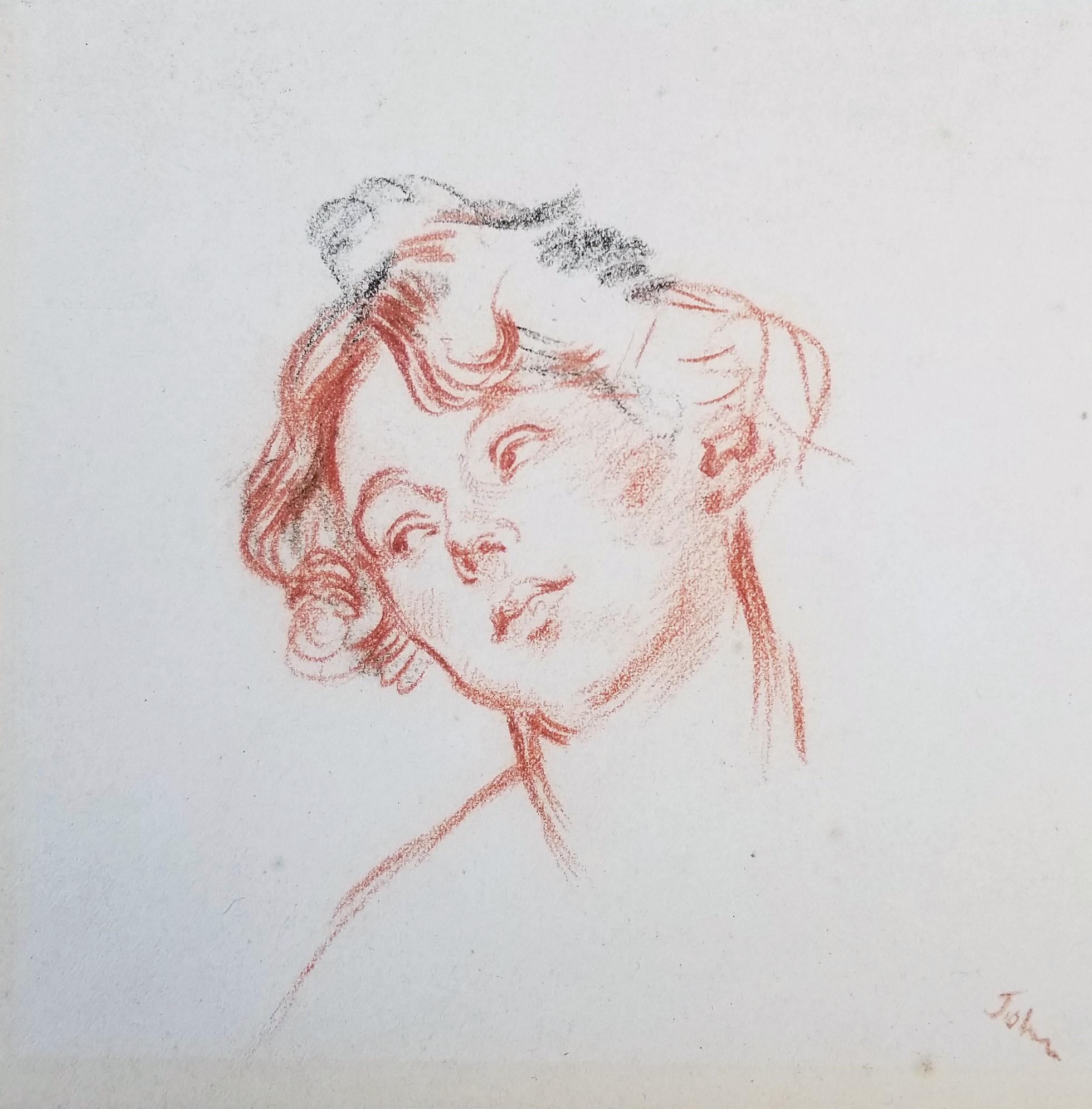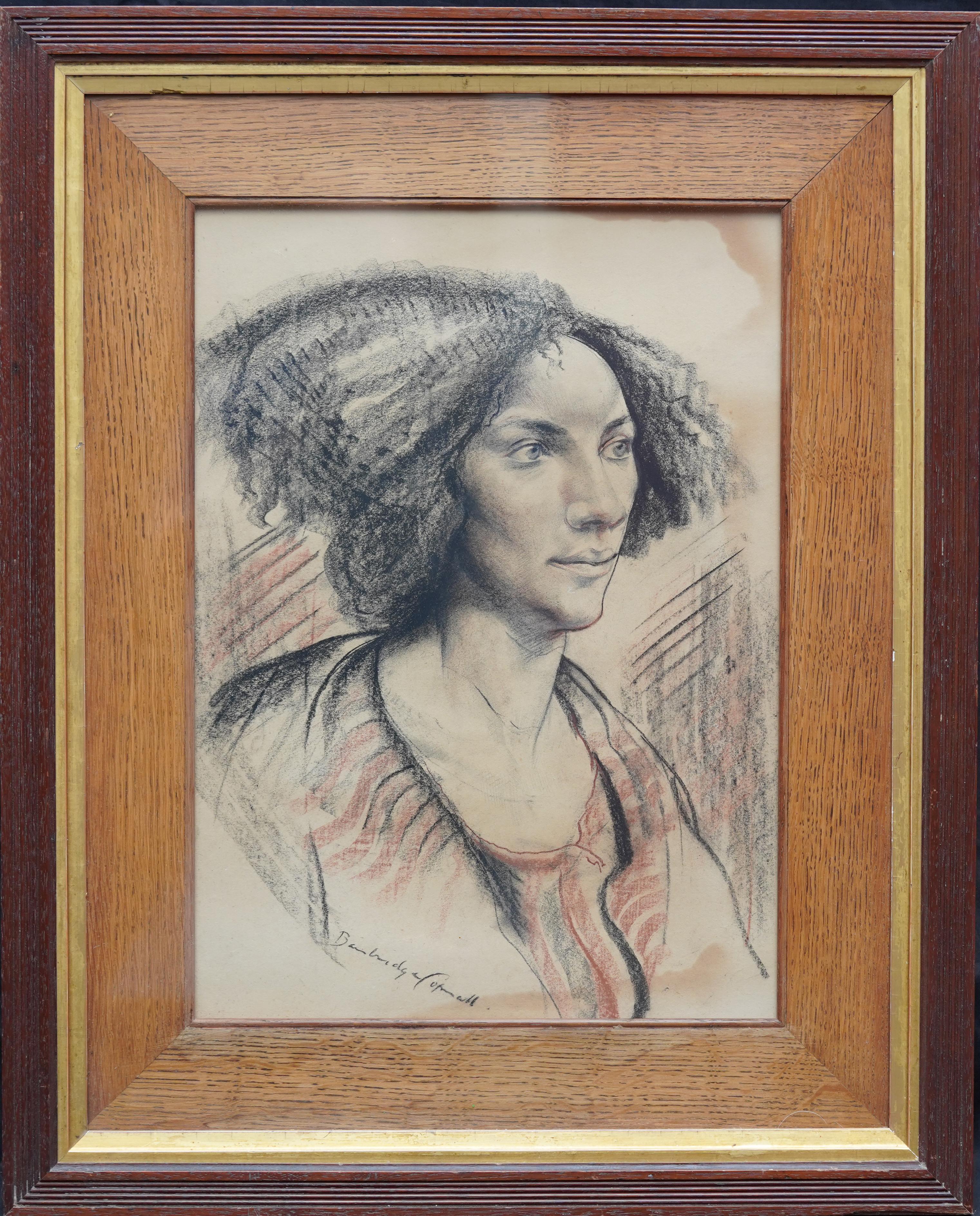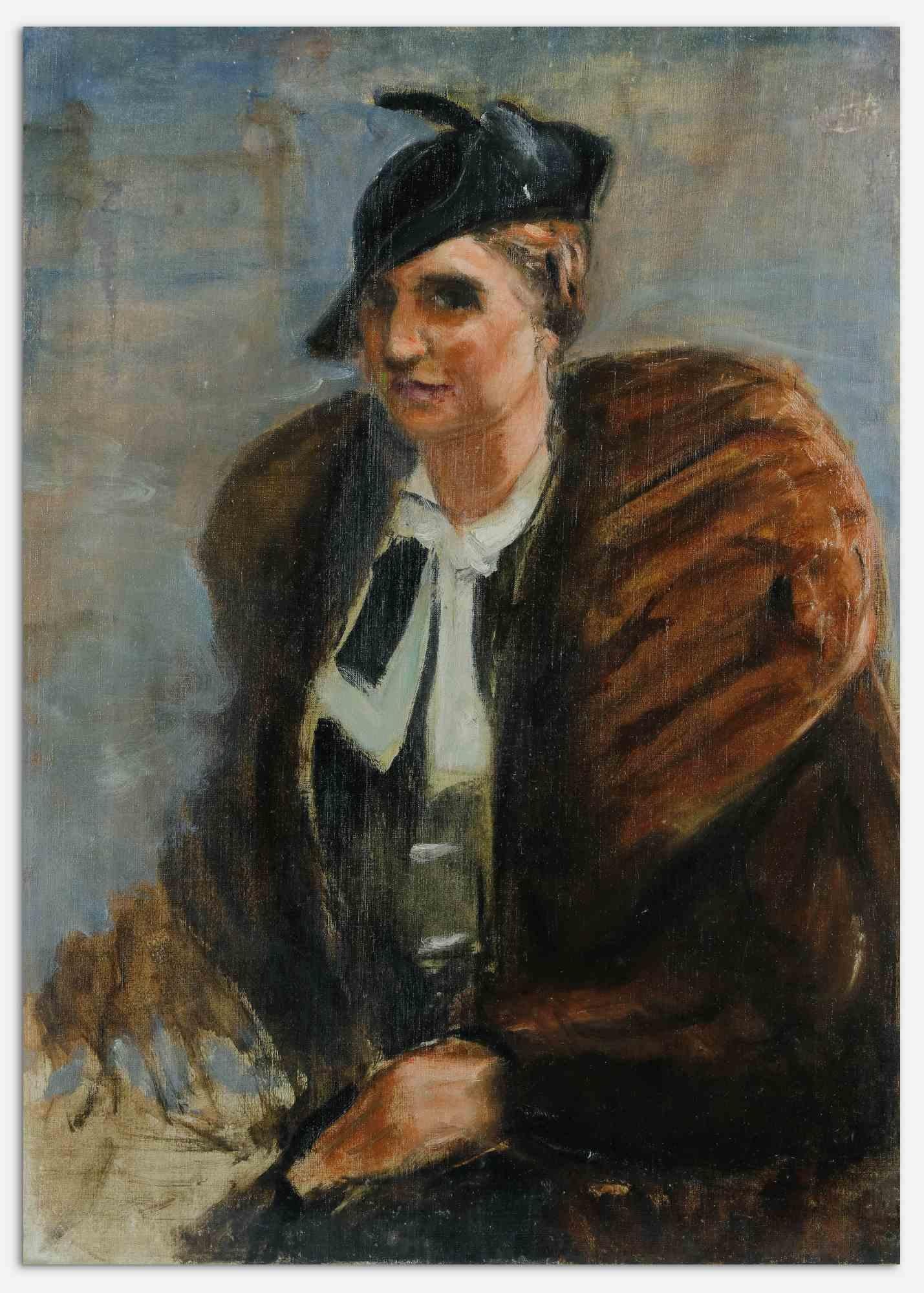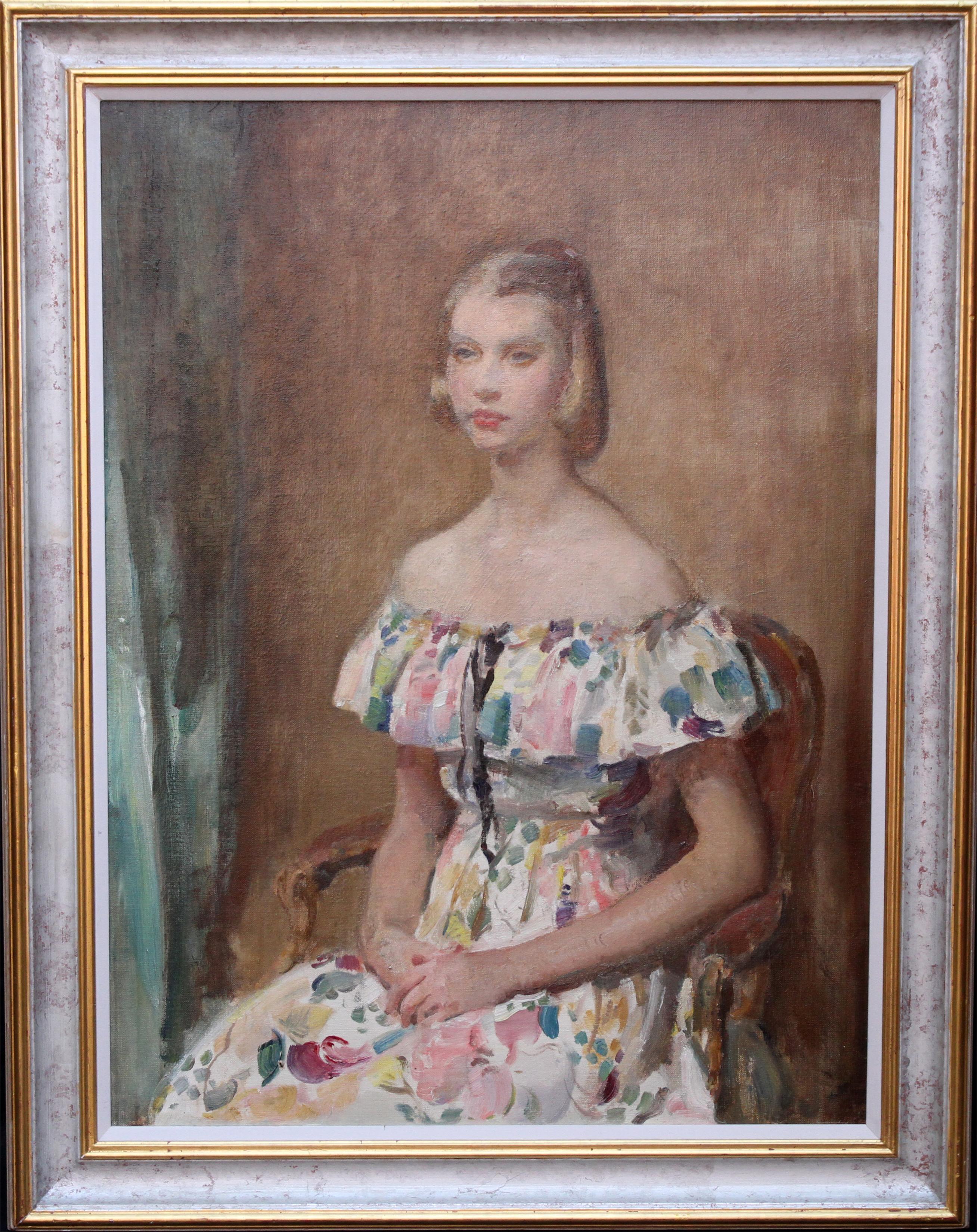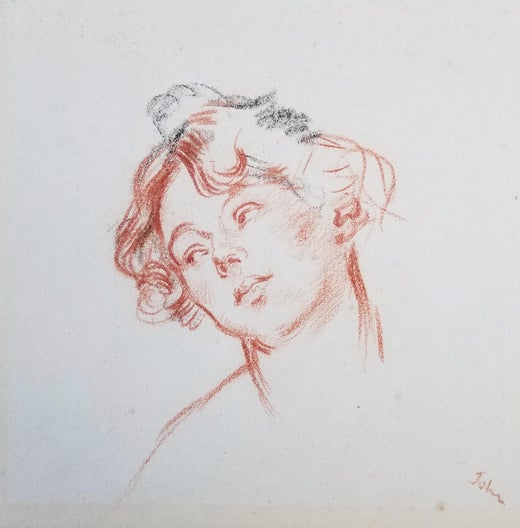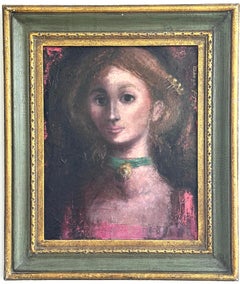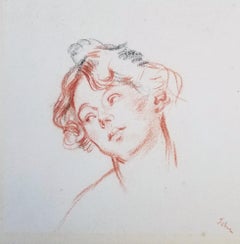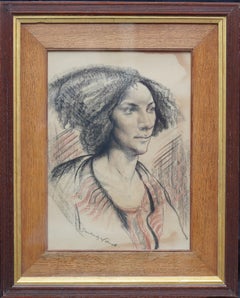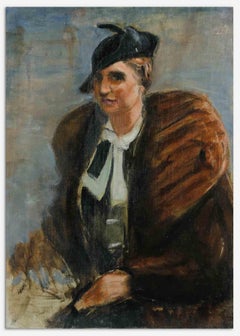Items Similar to Portrait of Barbara
Want more images or videos?
Request additional images or videos from the seller
1 of 15
Augustus Edwin JohnPortrait of Barbaraca. 1930
ca. 1930
$15,000
$20,00025% Off
£11,329.01
£15,105.3425% Off
€13,086.76
€17,449.0225% Off
CA$21,132.86
CA$28,177.1525% Off
A$22,633.31
A$30,177.7425% Off
CHF 12,167.51
CHF 16,223.3425% Off
MX$274,894.72
MX$366,526.2925% Off
NOK 153,742.40
NOK 204,989.8725% Off
SEK 140,762.60
SEK 187,683.4725% Off
DKK 97,782.04
DKK 130,376.0525% Off
About the Item
Augustus Edwin John (Welsh, 1878-1961). Portrait of Barbara, ca. 1930. oil on canvas, 11 5/8 x 14 5/8 inches. Framed dimension: 16 x 19 inches. Signed upper right. Original condition with no conservation or inpainting. Label fragment affixed on verso.
Augustus Edwin John OM, RA, (4 January 1878 - 31 October 1961) was a Welsh painter, draughtsman, and etcher*. For a short time around 1910, he was an important exponent of Post-Impressionism* in the United Kingdom.
"Augustus was celebrated first for his brilliant figure drawings, and then for a new technique of oil sketching. His work was favourably compared in London with that of Gauguin and Matisse. He then developed a style of portraiture that was imaginative and often extravagant, catching an instantaneous attitude in his subjects."
John was born at Tenby in Pembrokeshire, the younger son and third of four children in his family. His father was Edwin William John, a Welsh solicitor; his mother, Augusta Smith from a long line of Sussex plumbers, died young when he was six, but not before inculcating a love of drawing in both Augustus and his older sister Gwen. At the age of seventeen he briefly attended the Tenby School of Art, then studied at the Slade School of Art* in London (his sister, Gwen, was with him at the Slade and became an important artist in her own right), where he became the star pupil of drawing teacher Henry Tonks, and even before his graduation was recognized as the most talented draughtsman of his generation.
In the summer of 1897, John was seriously injured while swimming, and the lengthy convalescence that followed seems to have actually stimulated his adventurous spirit and accelerated his artistic growth. In 1898, he won the Slade Prize with Moses and the Brazen Serpent. John afterward studied independently in Paris where he seems to have been influenced by Puvis de Chavannes.
Some time in 1910, John fell in love with the town of Martigues, in Provence, located half-way between Arles and Marseilles, and first seen from a train en route to Italy. John wrote that Provence "had been for years the goal of my dreams" and Martigues was the town for which he felt the greatest affection. "With a feeling that I was going to find what I was seeking, an anchorage at last, I returned from Marseilles, and, changing at Pas des Lanciers, took the little railway which leads to Martigues. On arriving my premonition proved correct: there was no need to seek further." The connection with Provence continued until 1928, by which time John felt the town had lost its simple charm, and he sold his home there.
He was, throughout his life, particularly interested in the Romani people (whom he referred to as "Gypsies"), and sought them out on his frequent travels around the United Kingdom and Europe. For a time, shortly after his marriage, he and his family, which included his wife Ida, mistress Dorothy (Dorelia) McNeill, and John's children by both women, travelled in a caravan, in gypsy fashion. Later on he became the President of the Gypsy Lore Society, a position he held from 1937 until his death in 1961.
During World War I, he was attached to the Canadian forces as a war artist and made a number of memorable portraits of Canadian infantrymen. The end result was to have been a huge mural for Lord Beaverbrook and the sketches and cartoon for this suggest that it might have become his greatest large-scale work. However, like so many of his monumental conceptions, it was never completed. As a war artist, he was allowed to keep his facial hair and therefore, he and King George V were the only officers in the Allied forces to have a beard. After two months in France he was sent home in disgrace after taking part in a brawl. Lord Beaverbrook, whose intervention saved John from a court-martial, sent him back to France after he had produced a series of studies for the prospective Canadian War Memorial picture, although the only major work to result from the experience was Fraternity.
Although well-known early in the century for his drawings and etchings, the bulk of John's later work consisted of portraits, some of the best of which were of his two wives and his children. He was known for the psychological insight of his portraits, many of which were considered "cruel" for the truth of the depiction. Lord Leverhulme was so upset with his portrait that he cut out the head (since only that part of the image could easily be hidden in his vault) but when the remainder of the picture was returned by error to John there was an international outcry over the desecration.
By the 1920s John was Britain's leading portrait painter. John painted many distinguished contemporaries, including T. E. Lawrence, Thomas Hardy, W. B. Yeats, Lady Gregory, Tallulah Bankhead, George Bernard Shaw, the cellist Guilhermina Suggia, the Marchesa Casati and Elizabeth Bibesco. Perhaps his most famous portrait is of his fellow-countryman, Dylan Thomas, whom he introduced to Caitlin Macnamara, his sometime lover who later became Thomas' wife.
It was said that after the war his powers diminished as his bravura technique became sketchier. One critic has claimed that "the painterly brilliance of his early work degenerated into flashiness and bombast, and the second half of his long career added little to his achievement." However, from time to time his inspiration returned, as it did on a trip to Jamaica in 1937.[19] The works done in Jamaica between March and May 1937 evidence a resurgence of his powers, and amounted to "the St. Martin's summer of his creative genius".
Of his method for painting portraits John explained:
"Make a puddle of paint on your palette consisting of the predominant colour of your model's face and ranging from dark to light. Having sketched the features, being most careful of the proportions, apply a skin of paint from your preparation, only varying the mixture with enough red for the lips and cheeks and grey for the eyeballs. The latter will need touches of white and probably some blue, black, brown, or green. If you stick to your puddle (assuming that it was correctly prepared), your portrait should be finished in an hour or so, and be ready for obliteration before the paint dries, when you start afresh."
Early in 1900, he married his first wife, Ida Nettleship (1877-1907); the couple had five children. After her death in 1907, his mistress Dorothy "Dorelia" McNeill, a Bohemian style icon, became his partner and later became his second wife, with whom he had two children. One of his sons (by his first wife) was the prominent British Admiral and First Sea Lord Sir Caspar John. His daughter Vivien John (1915-1994) was a notable painter.
By Ian Fleming's widowed mother, Evelyn Ste Croix Fleming née Rose, he had a daughter, Amaryllis Fleming (1925-1999), who became a noted cellist. Another of his sons, by Mavis de Vere Cole, is the television director Tristan de Vere Cole noted for his contributions to TV series from the Sixties to the Eighties. His son Romilly (1906-1986) was in the RAF, briefly a civil servant, then a poet, author and an amateur physicist. Poppet (1912-1997), John's daughter by his second wife, married the Dutch painter Willem Jilts Pol (1905-1988) whose daughter Talitha (1940-1971), a fashion icon of 1960s London, married John Paul Getty, was famously photographed in Marrakesh by Patrick Lichfield, and, after a brief hedonistic life, died of a drug overdose. His daughter Gwyneth Johnstone (1915-2010), by musician Nora Brownsword, was an artist.
In later life, John wrote two volumes of autobiography, Chiaroscuro (1952) and Finishing Touches (1964). In old age, although John had ceased to be a moving force in British art, he was still greatly revered, as was demonstrated by the huge show of his work mounted by the Royal Academy in 1954.
He continued to work up until his death in Fordingbridge, Hampshire in 1961, his last work being a studio mural in three parts, the left hand of which showed a Falstaffian figure of a French peasant in a yellow waistcoat playing a hurdy gurdy while coming down a village street. It was Augustus John's final wave goodbye.
He joined the Peace Pledge Union as a pacifist in the 1950s, and on 17 September 1961, just over a month before his death, he joined the Committee of 100's anti-nuclear weapons demonstration in Trafalgar Square, London. At the time, his son, Admiral Sir Caspar John was First Sea Lord and Chief of Naval Staff.
He is said to have been the model for the bohemian painter depicted in Joyce Cary's novel The Horse's Mouth, which was later made into a 1958 film of the same name with Alec Guinness in the lead role.
Michael Holroyd published a biography of John in 1975 and it is a mark of the public's continued interest in the painter that Holroyd published a new version of the biography in 1996.
He became a leader of the New English Art Club, where he chiefly exhibited. With his vivid manner of portraiture and his ability to catch unerringly some striking and usually unfamiliar aspect of his subject, he superseded Sargent as England's fashionable portrait painter. In 1921 he was elected an Associate of the Royal Academy* and elected a full R.A. in 1928. He was named to the Order of Merit by King George VI in 1942. He was a trustee of the Tate Gallery* from 1933 to 1941 and President of the Royal Society of Portrait Painters* from 1948 to 1953.
- Creator:Augustus Edwin John (1878-1961, British)
- Creation Year:ca. 1930
- Dimensions:Height: 14.63 in (37.17 cm)Width: 11.63 in (29.55 cm)Depth: 0.35 in (8.89 mm)
- Medium:
- Movement & Style:
- Period:
- Condition:
- Gallery Location:Wilton Manors, FL
- Reference Number:1stDibs: LU245213414992
Augustus Edwin John
Augustus John, in full Augustus Edwin John, (born January 4, 1878, Tenby, Pembrokeshire, Wales—died October 31, 1961, Fordingbridge, Hampshire, England), Welsh painter who was an accomplished portraitist, muralist, and draughtsman. John studied at the Slade School of Fine Art in London from 1894 to 1898. By age 20 he had won a reputation as one of the most brilliant draughtsmen in England. His portraits and other paintings done around 1900 gained attention for their vigour and skillful technique. John was greatly influenced by the work of Old Master painters, especially Peter Paul Rubens, as can be seen in the strong and sensuous Smiling Woman (c. 1908), a portrait of John’s second wife, Dorelia. John was known as a colourful personality who adopted an individualistic and bohemian lifestyle. Intrigued by gypsy culture and the Romany language, he spent periods traveling with gypsy caravans over Wales, Ireland, and Dorset. He based much of his work on these experiences, such as the painting Encampment on Dartmoor (1906). John was more modern in his approach to landscape painting, as seen in the bright palette and loose brushwork of paintings such as Llyn Trewereyn (1911–12) and The Little Railway, Martigues (1928).
About the Seller
4.9
Platinum Seller
Premium sellers with a 4.7+ rating and 24-hour response times
Established in 2007
1stDibs seller since 2015
447 sales on 1stDibs
Typical response time: 2 hours
- ShippingRetrieving quote...Shipping from: Wilton Manors, FL
- Return Policy
More From This Seller
View AllPortrait of a Young Woman
Located in Wilton Manors, FL
Jose Mitjans Pico (1904-1991).
Portrait of a Young Woman
Oil on canvas 20 x 16 in, 27 x 23 in (framed).
Signed right margin.
Category
Mid-20th Century Realist Portrait Paintings
Materials
Canvas, Oil
Portrait of Stylish Woman
By George Luks
Located in Wilton Manors, FL
Beautiful Ashcan School portrait of a woman in winter outerwear, 1909.
Oil on canvas panel, measuring 17.75 x 18 inches; 21.75 x 22 inches framed. Original frame.
Dated lower rig...
Category
Early 1900s Ashcan School Figurative Paintings
Materials
Oil, Board
Italian ca. 1960's Beautiful Young Woman Portrait
Located in Wilton Manors, FL
Portrait of a Beautiful Young Woman, ca. 1965.
Oil on linen canvas, 8 x 10 inches.
Framed measurement: 10.5 x 12.5 inches.
Signed indistinctly lower left.
Category
Mid-20th Century Modern Portrait Paintings
Materials
Canvas, Oil
Art Deco Portrait of a Woman
Located in Wilton Manors, FL
Laura M. GREENWOOD (1897-1951).
Portrait of Woman in Head Shawl
Oil on canvas, 8 x 10 inches.
Signed upper stretcher verso. Excellent condition. Would benefit from a cleaning. O...
Category
1930s Art Deco Figurative Paintings
Materials
Oil
Portrait of a Young Woman
Located in Wilton Manors, FL
Bedrich Fritta (1906-1944).
Portrait of a Young Woman in Profile, ca. 1930.
Pencil on irregular paper sheet measuring 6 x 6.75 inches. Mounted on thin backing measuring 9 x 12 in...
Category
1930s Art Deco Portrait Drawings and Watercolors
Materials
Paper, Pencil
Portrait of a Young Woman
Located in Wilton Manors, FL
Bedrich Fritta (1906-1944).
Portrait of a Young Woman in Profile, ca. 1930.
Pencil on irregular paper sheet measuring 3.25 x 7 inches. Mounted on thin backing measuring 9 x 12 inc...
Category
1930s Art Deco Portrait Drawings and Watercolors
Materials
Paper, Pencil
You May Also Like
Portrait of a Young Woman - British Edwardian art female portrait oil painting
By James Jebusa Shannon
Located in Hagley, England
An original oil on canvas on panel by Sir James Jebusa Shannon. The portrait dates to the Edwardian period and depicts a bold British Impressionist painting of a beautiful young woma...
Category
Early 1900s Impressionist Portrait Paintings
Materials
Oil
Portrait of a Lady /// Impressionism British Augustus Edwin John Drawing Red
By Augustus Edwin John
Located in Saint Augustine, FL
Artist: Augustus Edwin John (Welsh, 1878-1961)
Title: "Portrait of a Lady"
*Signed by John lower right
Circa: 1910
Medium: Original red and black Chalk Drawing on wove paper
Framing:...
Category
1910s Post-Impressionist Portrait Drawings and Watercolors
Materials
Chalk, Charcoal
Portrait of a Lady - British art Post Impressionist 40s drawing female portrait
By Edward Bainbridge Copnall
Located in Hagley, England
A dramatic head and shoulders portrait of a lady in coloured chalks attributed to noted British artist Edward Bainbridge Copnall. This is just a stunning artwork which dates to circa 1940.
Signed Bainbridge Copnall.
Provenance. Midlands collection.
Condition. Coloured chalks on paper, 16 inches by 13 inches and in good colour and condition. Some staining to edges.
Housed in its original gallery frame 21 by 18 inches. In excellent condition.
Edward Bainbridge Copnall MBE ( 1903-1973) was a British sculptor and painter. He was best known for his architectural and decorative sculptures featuring allegorical and religious subjects. He was the President of the Royal Society of Sculptors from 1961 - 1966. Edward Bainbridge Copnall was born in Cape Town, South Africa in 1903 and moved to Horsham, West Sussex in England as a young child after the death of his mother. His father, photographer Edward White Copnall (born 1878, Isle of Wight), lived and worked in Horsham from 1915-1962. His uncle was Liverpool-based portrait painter Frank Thomas Copnall...
Category
Early 20th Century Realist Portrait Drawings and Watercolors
Materials
Chalk
Portrait of Woman- Painting by Antonio Feltrinelli- 1930s
By Antonio Feltrinelli
Located in Roma, IT
Portrait of Woman is an orignal modern artwork realized by Antonio Feltrinelli in 1930s.
Mixed colored oil painting on canvas.
Not signed.
Antonio Feltrinelli (Milan, 1887 – Gargn...
Category
1960s Modern Figurative Paintings
Materials
Paint, Oil
Post Impressionist Portrait of a Woman - British 40's art portrait oil painting
By Harry Rutherford
Located in Hagley, England
This striking British Post Impressionist portrait oil painting is by noted Manchester artist Harry Rutherford. Painted circa 1940, the portrait is of a dark haired young woman in a f...
Category
1940s Post-Impressionist Portrait Paintings
Materials
Oil
Portrait of a Young Lady - British art 20's Impressionist oil painting portrait
By Walter Ernest Webster
Located in Hagley, England
This lovely portrait was painted circa 1920 by the noted British Impressionist portrait painter Walter Ernest Webster. This painting depicts a beautiful young woman in an Impressioni...
Category
1920s Impressionist Portrait Paintings
Materials
Oil

